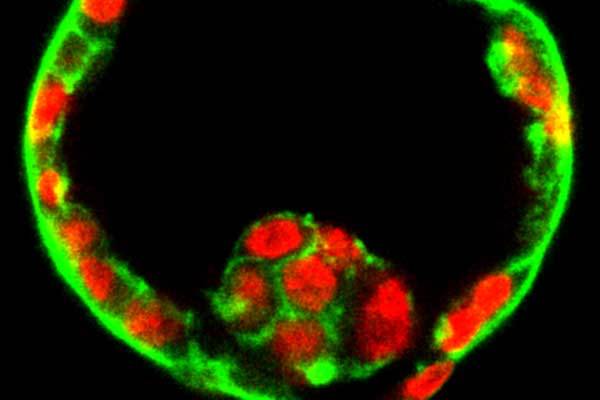A few days after fertilization, the embryo is already made up of a hundred cells from which all the organs and tissues of the body will come out. These early stages of development raise many questions for researchers: issues that concern infertility and pregnancy losses, but also diseases that do not appear until much later in life and whose origin can be influenced by how cells are organized from conception.
Now, and for the first time, scientists can count on a useful model to investigate the embryo in its five or six days of life (blastocyst) . It is a structure similar to the natural blastocysts born in the laboratory with the name of 'blastoid', thanks to the joint work of the Southwestern Medical Center of the University of Texas and the Laboratory of Genetic Expression directed by Juan Carlos Izpisúa at the Institute Salk, in California.
The procedure to obtain the 'blastoids', described in the journal 'Cell', consists of extracting cells from the skin of adult mice (they have done so with fibroblasts from the ear, and also in parallel, with mouse embryonic cells) at that return their ability to differentiate into any cell type, becoming reprogrammed cells or iPS. Then, they grouped several of these iPS into a culture medium with chemicals (factors) that induced the cells to form structures similar to the embryo.
The last 'organoids'
Izpisúa points out to DM that blastoids "have the potential to give rise to all tissues of an adult organism." In recent years, several types of human organs have been reproduced in the test tube (from the stomach to a 'mini-brakes'). The synthetic embryos that are presented now extend this family of the so-called 'organoids', but with the aim of being much more than research models: "In the development of the 'organoids', it is important to start with the cells in very early stages that they can go to develop specific pathways. For example, to get a cerebral 'organoid' , you don't want to start with the cells that were already on their way to becoming a renal 'organoid'. These 'blastoids' are unique in their early development , which could allow a more successful obtaining of a variety of 'organoids.' The 'blastoids' created in our study, in a sense, are the last 'organoids', he reflects.
Personal stamp
The findings of the hellinero researcher can follow very diverse paths, but a constant in his work, almost a personal seal, is to answer a very simple question to ask: how a human being can leave a cell.
"We anticipate that these 'blastoids' will catalyze research in many different areas to understand the beginnings of life and promote health," says the scientist, for whom the new research models will allow "to carry out toxicity and drug detection tests to identify harmful environmental factors "for the embryo, or, conversely, substances that are useful as" future therapies . "
In fact, synthetic blastocysts come to solve one of the problems that embryologists encounter when studying early development, and that is that animal models do not produce these tissues in sufficient quantity.
"Using our method, virtually all types of cells can be used to achieve blastoids," Izpisúa notes , with the advantage that "we do not need to use embryonic cells or natural blastocysts."
Although 'blastoids' share many similarities with natural blastocysts, they did not form viable embryos, but continued to grow in a disorganized manner.
Among the factors, still unknown, that prevent obtaining a functional embryo, Izpisúa speculates that "our in vitro condition is not the same as that of the in vivo environment ; in the future we will need to develop a condition that mimics the latter."
In addition, when comparing them, they have identified genes that are regulated differently, in which the researcher sees an opportunity, since the study of these differences could provide clues about the initial stages of the embryo. "The development of mammals is very complex and we are still in the early stages of this research, but we hope that this type of work helps to acquire knowledge."
According to the criteria of The Trust Project
Know more- Science and Health
- Health
HealthElectronic cigarettes are not for smoking cessation, 'Champix' yes
Oncology New approach to advanced ovarian cancer
Boticaria García Ibuprofen-drama: why they no longer give you your favorite medication without a prescription

